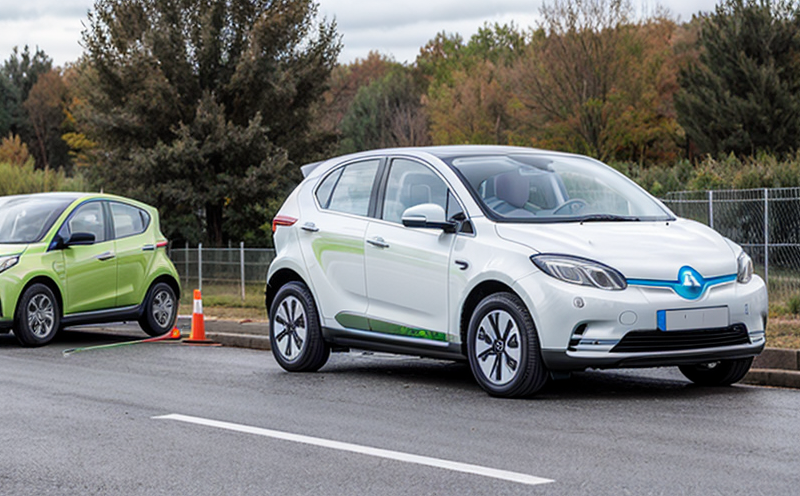IEC 63218 EV Lithium-Ion Battery Testing for Aerospace Applications
The IEC (International Electrotechnical Commission) Standard 63218 has been developed to ensure that lithium-ion batteries used in electric vehicles (EVs) meet the stringent requirements of aerospace applications. This standard is particularly critical for ensuring safety, reliability, and performance under extreme conditions such as temperature variations, high altitudes, and mechanical stress.
The aerospace industry demands a high level of safety and robustness from its components, especially those that power critical systems like flight control and emergency equipment. Lithium-ion batteries are the preferred choice due to their energy density, but they must undergo rigorous testing to ensure they can withstand the unique challenges faced in this sector.
The tests outlined in IEC 63218 are designed to simulate real-world conditions that a lithium-ion battery might encounter during its lifecycle. This includes thermal cycling, vibration testing, altitude simulation, and high/low temperature storage. Each of these tests is critical for assessing the battery's ability to maintain its performance under extreme conditions.
The standard also emphasizes the importance of mechanical integrity checks, ensuring that the batteries can withstand impacts and vibrations without compromising their structural integrity or electrical function. The aerospace sector often operates in environments where even minor failures could lead to catastrophic consequences, making these tests indispensable for quality assurance.
One of the key aspects of IEC 63218 is its focus on long-term durability testing. This involves placing batteries through numerous cycles of charge and discharge under various conditions to assess their longevity. The results from this testing are crucial for understanding how these batteries will perform over extended periods, which is especially important given the lifecycle of aerospace equipment.
Another critical component of IEC 63218 involves verifying the battery's thermal management capabilities. In aerospace applications, overheating can be particularly dangerous and could lead to catastrophic failure. Therefore, testing batteries for their ability to dissipate heat efficiently is essential. This includes evaluating both passive cooling systems (such as insulation) and active cooling systems.
| Test Type | Description | Application |
|---|---|---|
| Thermal Cycling | The battery is subjected to repeated cycles of heating and cooling. | Ensures the battery can operate in extreme temperature conditions during flight. |
| Vibration Testing | Battery is exposed to simulated vibration environments similar to those encountered during launch and operation. | Evaluates the battery's resilience against mechanical stress. |
| Altitude Simulation | The battery operates at high altitudes, simulating conditions found in thin atmospheres. | Verifies performance and stability under reduced pressure environments. |
| High/low Temperature Storage | Battery is stored for extended periods at extreme temperatures. | Evaluates the long-term impact of temperature extremes on battery performance. |
Benefits
The benefits of adhering to IEC 63218 for EV lithium-ion batteries in aerospace applications are numerous. Firstly, it ensures that the batteries meet the highest safety and performance standards required by this critical industry. This enhances the overall reliability and safety of aircraft systems powered by these batteries.
Secondly, compliance with IEC 63218 helps manufacturers to avoid costly recalls and product failures by identifying potential issues early in the development process. This not only saves money but also improves brand reputation. Thirdly, it facilitates smoother regulatory approval processes, as adherence to international standards is often a prerequisite for certification.
- Enhanced safety
- Improved reliability and performance
- Avoidance of costly failures
- Facilitated regulatory compliance
- Better brand reputation
- Faster market entry
The standard also promotes innovation by encouraging manufacturers to explore new materials and designs that meet these stringent requirements. This leads to advancements in battery technology, which can then be applied across other sectors as well.
Quality and Reliability Assurance
To ensure the quality and reliability of batteries tested according to IEC 63218, several key steps are followed. These include precise specimen preparation, rigorous test protocols, and meticulous data analysis.
- Specimen Preparation: Lithium-ion cells or complete battery packs are prepared in accordance with the standard's specifications to ensure accurate testing.
- Test Protocols: Each test is conducted under controlled conditions, ensuring that the results are repeatable and reliable. This includes using calibrated equipment and maintaining strict environmental controls.
- Data Analysis: Comprehensive data from each test is analyzed to identify any discrepancies or deviations from expected performance. This data is used to refine future tests and improve battery design.
In addition, the laboratory adheres to international standards such as ISO 12405 for cell testing and IEC 63218-1 for system-level testing. These standards provide a framework for conducting these tests accurately and consistently.





